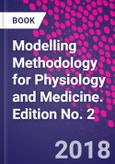Modelling Methodology for Physiology and Medicine, Second Edition, offers a unique approach and an unprecedented range of coverage of the state-of-the-art, advanced modeling methodology that is widely applicable to physiology and medicine. The second edition, which is completely updated and expanded, opens with a clear and integrated treatment of advanced methodology for developing mathematical models of physiology and medical systems. Readers are then shown how to apply this methodology beneficially to real-world problems in physiology and medicine, such as circulation and respiration.
The focus of Modelling Methodology for Physiology and Medicine, Second Edition, is the methodology that underpins good modeling practice. It builds upon the idea of an integrated methodology for the development and testing of mathematical models. It covers many specific areas of methodology in which important advances have taken place over recent years and illustrates the application of good methodological practice in key areas of physiology and medicine. It builds on work that the editors have carried out over the past 30 years, working in cooperation with leading practitioners in the field.
Table of Contents
1. An introduction to modelling methodology2. Control in Physiology and Medicine
3. Deconvolution
4. A priori identifiability of physiological parametric models
5. Parameter estimation
6. New Trends in nonparametric linear system identification
7. Population Modelling
8. Systems Biology
9. Genomic Regulatory Networks
10. Tracer experiment design for metabolic fluxes estimation in steady and nonsteady state
11. Physiological modelling of positron emission tomography images
12. Downstream from Heart Left Ventricle: Aortic Impedance Interpretation by Lumped- and Tube-load Models
13. Mathematical modelling of pulmonary gas exchange
14. Acid- base modelling
15. Insulin modelling
16. Glucose modelling
17. Blood-tissue exchange modelling
18. Stochastic modelling of physiological systems
19. Tumour growth modelling for drug development
20. Modelling cardiac biomechanics
21. Finite element modelling in musculoskeletal biomechanics
22. Probabilistic modelling with Bayesian networks
23. Modelling for synthetic biology
24. Mathematical models for computational neuroscience








